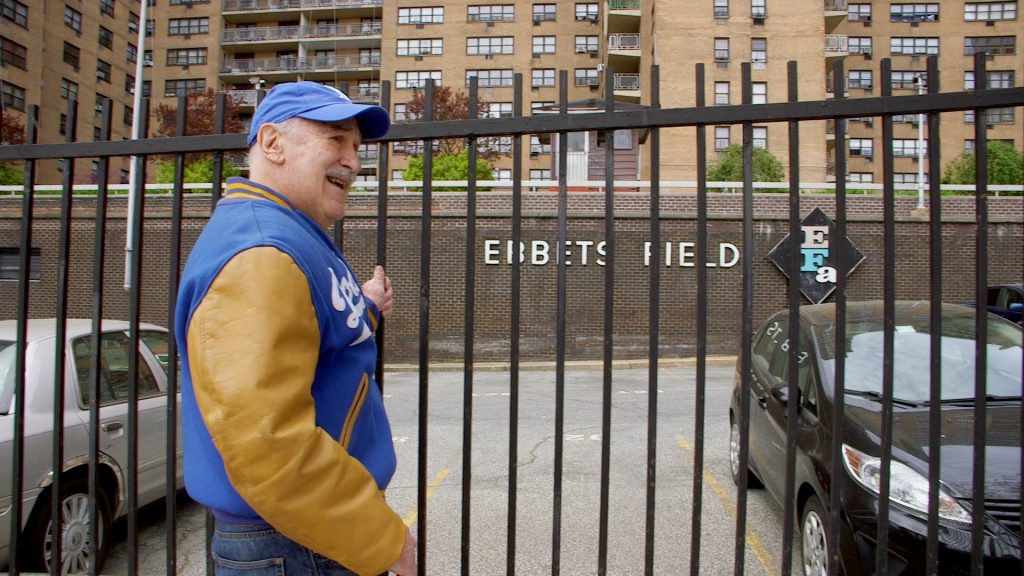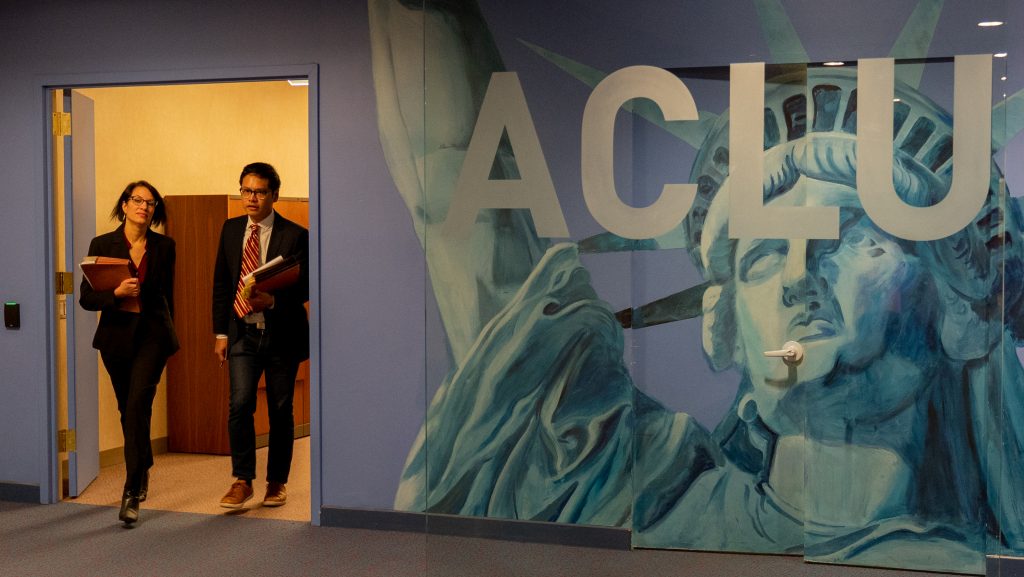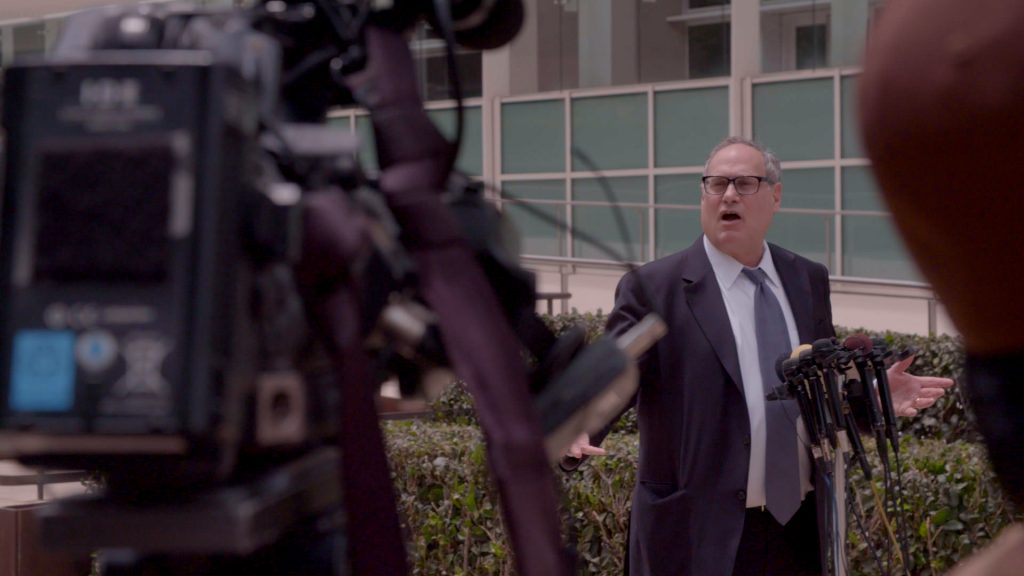March 8, 2021
by Carla Hay

“Ruth: Justice Ginsburg in Her Own Words”
Directed by Freida Lee Mock
Culture Representation: “Ruth: Justice Ginsburg in Her Own Words” features a predominantly white group of people (with one African American and one Asian), mostly with law backgrounds, discussing the life and legacy of former U.S. Supreme Court Justice Ruth Bader Ginsberg, who died in 2020, at the age of 87.
Culture Clash: Ginsburg faced discrimination issues because of her gender and for being Jewish, and her politically liberal viewpoints conflicted with the viewpoints of many political conservatives.
Culture Audience: “Ruth: Justice Ginsburg in Her Own Words” will appeal to primarily to people who are admirers of Ginsberg who tend to be liberal or progressive when it comes to social justice issues.

Although not as intimate or insightful as the Oscar-nominated 2018 documentary “RBG,” the documentary “Ruth: Justice Ginsburg in Her Own Words” can still be considered a worthy overview of the life and legacy of former U.S. Supreme Court Justice Ruth Bader Ginsburg, who died of pancreatic cancer in 2020, at the age of 87. She became a U.S. Supreme Court Justice in 1993 (the second woman to hold this title), and she never retired.
Directed by Oscar-winning documentarian Freida Lee Mock, “Ruth: Justice Ginsburg in Her Own Words” is comprised mostly of archival footage of Ginsburg. There are also exclusive documentary interviews with some of her former colleagues, her “Notorious RBG” unauthorized biographers, and two people whose lives were directly affected by U.S. Supreme Court decisions made by Ginsburg. Fortunately, the documentary isn’t overstuffed with talking heads and doesn’t lose sight of Ginsburg’s words being the focus of the film.
The biggest difference between “RBG” (which was directed by Julie Cohen and Betsy West) and “Ruth: Justice Ginsburg in Her Own Words” is that the latter film does not have the participation of Ginsburg or her family. It’s a big void that “Ruth: Justice Ginsburg in Her Own Words” tries to fill by taking an in-depth look at the most well-known cases that Ginsburg was involved with in her long and illustrious career. Therefore, “Ruth: Justice Ginsburg in Her Own Words” has more audio clips of Ginsburg speaking in court during these cases, especially when voicing her deciding opinion. The documentary includes some simple animation to illustrate scenes from her life where video footage doesn’t exist.
“Ruth: Justice Ginsburg in Her Own Words” was filmed when Ginsburg was still alive but battling her health problems. (It’s why everyone in the movie refers to her in the present tense.) But her legacy looms large and will be felt for generations to come. This documentary hits a lot of the same beats and uses a lot of the same archival footage that “RBG” used. Therefore, people who saw “RBG” probably won’t learn anything new about Ginsburg, except maybe seeing some archival footage that they might not have seen before.
For example, a clip that’s in “Ruth: Justice Ginsburg in Her Own Words” that isn’t in “RBG” is of Ginsburg appearing on a Columbia University Law School discussion panel for mothers and daughters who are lawyers. Ginsburg was on the panel with her daughter Jane Ginsburg, and it’s mentioned that they were the first mother and daughter to become professors at a U.S. law school. (Ruth and Jane both taught at Columbia University Law School, their alma mater.)
There’s also footage of Ruth going back to her childhood schools in her hometown of New York City (she was born and raised in the Brooklyn borough) to attend dedication events when they named a part of a building for her. At her former elementary school (Public School 238), the library is named after her. In the archival footage, Ruth says it was always her favorite room in the school when she was a student there. And at James Madison High School, they named the moot court after her.
And there are segments of her answering questions over the years from various U.S. students who came to visit at the U.S. Supreme Court building. In this archival footage, Ruth comments that meeting with students is one of her favorite things to do and she wishes that she could do it more often. There’s also expected archival footage of her U.S. Senate confirmation hearings in 1993, with Joe Biden as a prominent figure because he was a member of the U.S. Senate Committee on the Judiciary at the time. In archival footage, Ruth graciously gives credit to Sandra Day O’Connor for paving the way as the first female U.S. Supreme Court Justice and for being so welcoming of Ruth.
The documentary doesn’t do too much in-depth coverage of Ginsburg’s life before she graduated from law school. It’s mainly because she didn’t publicly talk too much about her what her life was like before she went to college, and this documentary relies entirely on her public statements for any of her comments that are in the movie. Ruth’s beloved mother Celia (who encouraged Ruth to be a strong, independent woman) died when Ruth was 17, the day before Ruth graduated from high school. And Ruth’s older sister died when Ruth was a baby. In the documentary, Ruth’s unauthorized biographer Irin Carmon (co-author of “Notorious RBG: The Life and Times of Ruth Bader Ginsburg”) mentions that these family tragedies probably affected Ruth’s resilience and ability to deal with other adversities that Ruth experienced later in her life.
Ruth’s courtship with husband Marty is described through archival clips that were also in “RBG.” They met while they both were undergraduate students at Cornell University. Ruth and Marty were married in 1954, the year that she graduated from Cornell, and the couple remained happily married until Marty’s death from cancer in 2010, at the age of 78.
Ruth and Marty attended Harvard University Law School, where she was one of the few women in her class. Marty graduated from Harvard, and Ruth later transferred to Columbia University Law School when Marty got a job in New York City. They had two children together: daughter Jane (an attorney/law professor) and son James (a music producer).
It’s also repeated how Ruth and Marty had opposite personalities: She was introverted and serious, while he was extroverted and a constant jokester. What isn’t mentioned in “Ruth: Justice Ginsburg in Her Own Words” but is detailed in “RBG” (and in the 2018 Ruth Bader Ginsburg feature film “On the Basis of Sex”) is that Ruth and Marty experienced a major health crisis early in their marriage.
While they were both attending Harvard Law School and when Jane was a baby, Marty was diagnosed with testicular cancer in 1957. He was given a very slim chance to live. Fortunately, Marty recovered from the cancer, but the couple had the enormous challenge of dealing with his recovery while they were both enrolled in school and taking care of a baby. Ruth had to attend Marty’s classes as well as her own to take notes for him while he was in recovery.
The “Ruth” documentary repeats the well-known story of how Ruth faced gender and religious discrimination after graduating at the top of her law-school class in 1959, but no law firm would hire her at the time. In job interviews, she was sometimes told that the firm didn’t hire attorneys who were women, Jews and/or mothers. In an archival clip, Ruth said that she fit all three of those descriptions when she tried to get hired at a law firm, so she had “three strikes against her.”
Of course, blatantly telling people in a job interview that they won’t be hired because of things such as gender, religion, race, etc. is illegal now in the United States, but there was no law against it back then. Most people who watch this documentary might already know how Ruth was one of the driving forces in the legal profession that helped make these discriminatory practices illegal. “Ruth: Justice Ginsburg in Her Own Words” doesn’t dwell too much on Ruth’s time as a Columbia law professor and instead keeps most of the focus on her work as an attorney and judge.
Kathleen Peratis was the director of the ACLU’s Women’s Rights Project from 1975 to 1979, so she and Ruth worked together during this period of time. Peratis comments in the documentary: “The ACLU [American Civil Liberties Union] was at the beginning of doing women’s rights work and was really at the beginning of the forefront of big-time gender discrimination legislation. And Ruth was at the head of it.”
The year 1976 was a milestone for Ruth. The documentary mentions three major cases in 1976 which helped define her career when she was an ACLU attorney. She won all of the cases. The Craig v. Boren lawsuit was an Oklahoma gender discrimination case that gave women the legal right to buy alcohol at age 18, while men had to wait until they were 21.
In archival commentary, Ruth said that a turning point in her career was winning the Reed vs. Reed case in 1976 in the U.S. Supreme Court. It was a case where Ruth represented Sally Reed, who had been prevented from being the administrator of her late son’s estate because she was a woman. In a 9-0 vote, it was the first time that the U.S. Supreme Court decided that gender discrimination was unconstitutional. Peratis comments, “Ruth spent the next 10 years just busting the doors open.”
M.E. Freeman, who would go on to become an attorney in New York, was a Columbia law student and ACLU volunteer when she worked with Ruth. Freeman remembers that in the Duren v. Missouri lawsuit in 1976 (a case arguing for women to have the same rights as men to serve on a jury), Ruth gave Freeman the privilege of sitting in during the U.S. Supreme Court proceedings as Ruth was making her arguments in the case. Freeman says it’s the type of mentor generosity that was rarely given to ACLU volunteers.
Freeman further comments on Ruth: “She was an amazing writer. Her expression was ‘If you can get the briefs to sing …’ And hers sang. They were powerful.” Goodwin Liu, who is a California Supreme Court associate justice, was a clerk for Ruth in 2000. He calls her an “independent thinker” and someone who was “an incredible mentor” to him, not just when he was in law school but also after he graduated and eventually became a judge. He says that even when Ruth was outvoted in U.S. Supreme Court cases, “She dissented with a purpose.”
One of the most well-known U.S. Supreme Court cases that had Ruth in the majority vote (7-1) was U.S. v. Virginia, which gave women the right to be allowed as students at the previously all-male Virginia Military Institute (VMI) in 1996. Jennifer Carroll Foy, who was one of the few women to graduate from VMI’s first co-ed class, comments in the documentary how this U.S. Supreme Court decision changed her life.
“There’s nothing that can prepare you for that experience,” Foy says of being in this groundbreaking co-ed VMI class. “My grandmother always told me: ‘Be the change you want to see.”
Foy adds, It’s very difficult to know where I would be right now without Justice Ginsburg and her opinion. She laid the foundation for all of us, especially me as a woman, to be able to attend the Virginia Military Institute. And I think it helped me reach the place I am today.”
Foy became a delegate for the 2nd district of the Virginia House of Delegates, a public defender and a 2021 candidate for governor of Virginia. Her personal life was also affected by her VMI experience, because VMI is where she met her husband Jeffrey Foy, and they are the parents of twin sons.
Also interviewed is Lilly Ledbetter, the plaintiff in Ledbetter v. Goodyear Tire and Rubber Company, which went to the U.S. Supreme Court in 2006. Ledbetter sued her employer Goodyear for being paid almost half of what male employees with equal or less experience were being paid for similar jobs in her department. In the documentary, Ledbetter says that she was a good, hardworking and loyal employee who was emotionally crushed when she found out about the pay discrepancy. She says she couldn’t afford to quit her job, so she found an attorney who would work on a contingency fee and she sued Goodyear to fight for her rights.
Although Ledbetter lost the case by a narrow 5-4 decision, Ruth was on the dissenting minority side and gave an eloquent courtroom speech explaining why. (Parts of that dissenting opinion are included in the documentary.) Ledbetter believes that this dissenting opinion helped pave the way for Lilly Ledbetter Fair Pay Restoration Act, which Barack Obama made the first act that he signed after he became president of the U.S. in 2009.
The documentary also mentions another U.S. Supreme Court case that was a tough blow for Ruth. In 2013, Shelby v. Holder repealed the progress made in the Civil Rights Voting Act of 1965. Ruth was in the minority dissenting opinion in the 5-4 vote.
Just like in “RBG,” Ruth’s unlikely friendship with politically conservative U.S. Supreme Court Justice Antonin Scalia, who died in 2016 at age 79, gets some screen time. (One of the few things they had in common was they both loved opera.) There’s archival footage of Ruth attending the Castleton Festival’s “Scalia/Ginsburg” parody musical and commenting to a reporter afterward about how the musical portrayed the real-life Scalia/Ginsburg relationship: “The song they sang ‘We Are Different, We Are One’ captures it. We each understand the way the other thinks.”
Also covered (as it was in “RBG”) is Ruth’s soaring popularity in her later years, including The Notorious RBG memes that resulted when she was satirically compared to rapper The Notorious B.I.G., another Brooklyn native. “Notorious RBG: The Life and Times of Ruth Bader Ginsburg” co-author Shana Knizhnik, who founded The Notorious RBG blog, provides additional comments about Ruth becoming an unexpected icon in pop culture. And there’s archival footage of Ruth describing her workout routine and mentioning her personal trainer Bryant Johnson, although this recycled footage doesn’t have the same impact as the exclusive “RBG” footage of her actually doing the workouts.
Erwin Chemerinsky, the dean of University of California at Berkeley Law School, says in the beginning of the “Ruth” documentary: “There’s remarkably little knowledge among college students about the [U.S] Supreme Court … I’ve seen opinion polls that more people could name the Seven Dwarfs than can name justices on the Supreme Court.” Ruth Bader Ginsberg is certainly an exception to the idea that U.S. Supreme Court Justices don’t have well-known names. And more importantly than being famous, as this “Ruth” documentary reaffirms, she’s left an important impact on U.S. law and inspired countless people, regardless of their personal politics.
Sanders & Mock Productions and American Film Foundation released “Ruth: Justice Ginsburg in Her Own Words” in select U.S. virtual cinemas on February 12, 2021. Starz premiered the movie on March 1, 2021. The movie’s VOD release date is on March 9, 2021.




